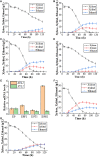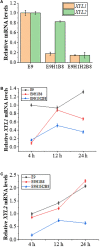Minimize the Xylitol Production in Saccharomyces cerevisiae by Balancing the Xylose Redox Metabolic Pathway
- PMID: 33718341
- PMCID: PMC7953151
- DOI: 10.3389/fbioe.2021.639595
Minimize the Xylitol Production in Saccharomyces cerevisiae by Balancing the Xylose Redox Metabolic Pathway
Abstract
Xylose is the second most abundant sugar in lignocellulose, but it cannot be used as carbon source by budding yeast Saccharomyces cerevisiae. Rational promoter elements engineering approaches were taken for efficient xylose fermentation in budding yeast. Among promoters surveyed, HXT7 exhibited the best performance. The HXT7 promoter is suppressed in the presence of glucose and derepressed by xylose, making it a promising candidate to drive xylose metabolism. However, simple ectopic expression of both key xylose metabolic genes XYL1 and XYL2 by the HXT7 promoter resulted in massive accumulation of the xylose metabolic byproduct xylitol. Through the HXT7-driven expression of a reported redox variant, XYL1-K270R, along with optimized expression of XYL2 and the downstream pentose phosphate pathway genes, a balanced xylose metabolism toward ethanol formation was achieved. Fermented in a culture medium containing 50 g/L xylose as the sole carbon source, xylose is nearly consumed, with less than 3 g/L xylitol, and more than 16 g/L ethanol production. Hence, the combination of an inducible promoter and redox balance of the xylose utilization pathway is an attractive approach to optimizing fuel production from lignocellulose.
Keywords: Saccharomyces cerevisiae; expression; promoter; xylitol; xylose.
Copyright © 2021 Zhu, Zhang, Zhu, Jia, Li, Xiao and Cao.
Conflict of interest statement
The authors declare that the research was conducted in the absence of any commercial or financial relationships that could be construed as a potential conflict of interest.
Figures





Similar articles
-
Fermentation of mixed glucose-xylose substrates by engineered strains of Saccharomyces cerevisiae: role of the coenzyme specificity of xylose reductase, and effect of glucose on xylose utilization.Microb Cell Fact. 2010 Mar 10;9:16. doi: 10.1186/1475-2859-9-16. Microb Cell Fact. 2010. PMID: 20219100 Free PMC article.
-
Feasibility of xylose fermentation by engineered Saccharomyces cerevisiae overexpressing endogenous aldose reductase (GRE3), xylitol dehydrogenase (XYL2), and xylulokinase (XYL3) from Scheffersomyces stipitis.FEMS Yeast Res. 2013 May;13(3):312-21. doi: 10.1111/1567-1364.12036. Epub 2013 Mar 4. FEMS Yeast Res. 2013. PMID: 23398717
-
Balance of XYL1 and XYL2 expression in different yeast chassis for improved xylose fermentation.Front Microbiol. 2012 Oct 5;3:355. doi: 10.3389/fmicb.2012.00355. eCollection 2012. Front Microbiol. 2012. PMID: 23060871 Free PMC article.
-
[Progress in research of pentose transporters and C6/C5 co-metabolic strains in Saccharomyces cerevisiae].Sheng Wu Gong Cheng Xue Bao. 2018 Oct 25;34(10):1543-1555. doi: 10.13345/j.cjb.180031. Sheng Wu Gong Cheng Xue Bao. 2018. PMID: 30394022 Review. Chinese.
-
Engineering of Saccharomyces cerevisiae for the efficient co-utilization of glucose and xylose.FEMS Yeast Res. 2017 Jun 1;17(4). doi: 10.1093/femsyr/fox034. FEMS Yeast Res. 2017. PMID: 28582494 Review.
Cited by
-
Construction of an economical xylose-utilizing Saccharomyces cerevisiae and its ethanol fermentation.FEMS Yeast Res. 2024 Jan 9;24:foae001. doi: 10.1093/femsyr/foae001. FEMS Yeast Res. 2024. PMID: 38268490 Free PMC article.
-
Saccharomyces cerevisiae for lignocellulosic ethanol production: a look at key attributes and genome shuffling.Front Bioeng Biotechnol. 2024 Sep 25;12:1466644. doi: 10.3389/fbioe.2024.1466644. eCollection 2024. Front Bioeng Biotechnol. 2024. PMID: 39386039 Free PMC article. Review.
-
Oxygenation influences xylose fermentation and gene expression in the yeast genera Spathaspora and Scheffersomyces.Biotechnol Biofuels Bioprod. 2024 Feb 7;17(1):20. doi: 10.1186/s13068-024-02467-8. Biotechnol Biofuels Bioprod. 2024. PMID: 38321504 Free PMC article.
-
Deletion of NGG1 in a recombinant Saccharomyces cerevisiae improved xylose utilization and affected transcription of genes related to amino acid metabolism.Front Microbiol. 2022 Sep 8;13:960114. doi: 10.3389/fmicb.2022.960114. eCollection 2022. Front Microbiol. 2022. PMID: 36160216 Free PMC article.
-
Engineering the xylose metabolism in Schizochytrium sp. to improve the utilization of lignocellulose.Biotechnol Biofuels Bioprod. 2022 Oct 26;15(1):114. doi: 10.1186/s13068-022-02215-w. Biotechnol Biofuels Bioprod. 2022. PMID: 36289497 Free PMC article.
References
-
- Baghel R. S., Trivedi N., Gupta V., Neori A., Reddy C. R. K., Lali A., et al. (2015). Biorefining of marine macroalgal biomass for production of biofuel and commodity chemicals. Green Chem. 17 2436–2443. 10.1039/c4gc02532f - DOI
-
- Bao X., Gao D., Qu Y., Wang Z., Walfridssion M., Hahnhagerbal B. (1997). Effect on product formation in recombinant Saccharomyces cerevisiae strains expressing different levels of xylose metabolic genes. Chin. J. Biotechnol. 13:225. - PubMed
LinkOut - more resources
Full Text Sources
Other Literature Sources
Molecular Biology Databases

